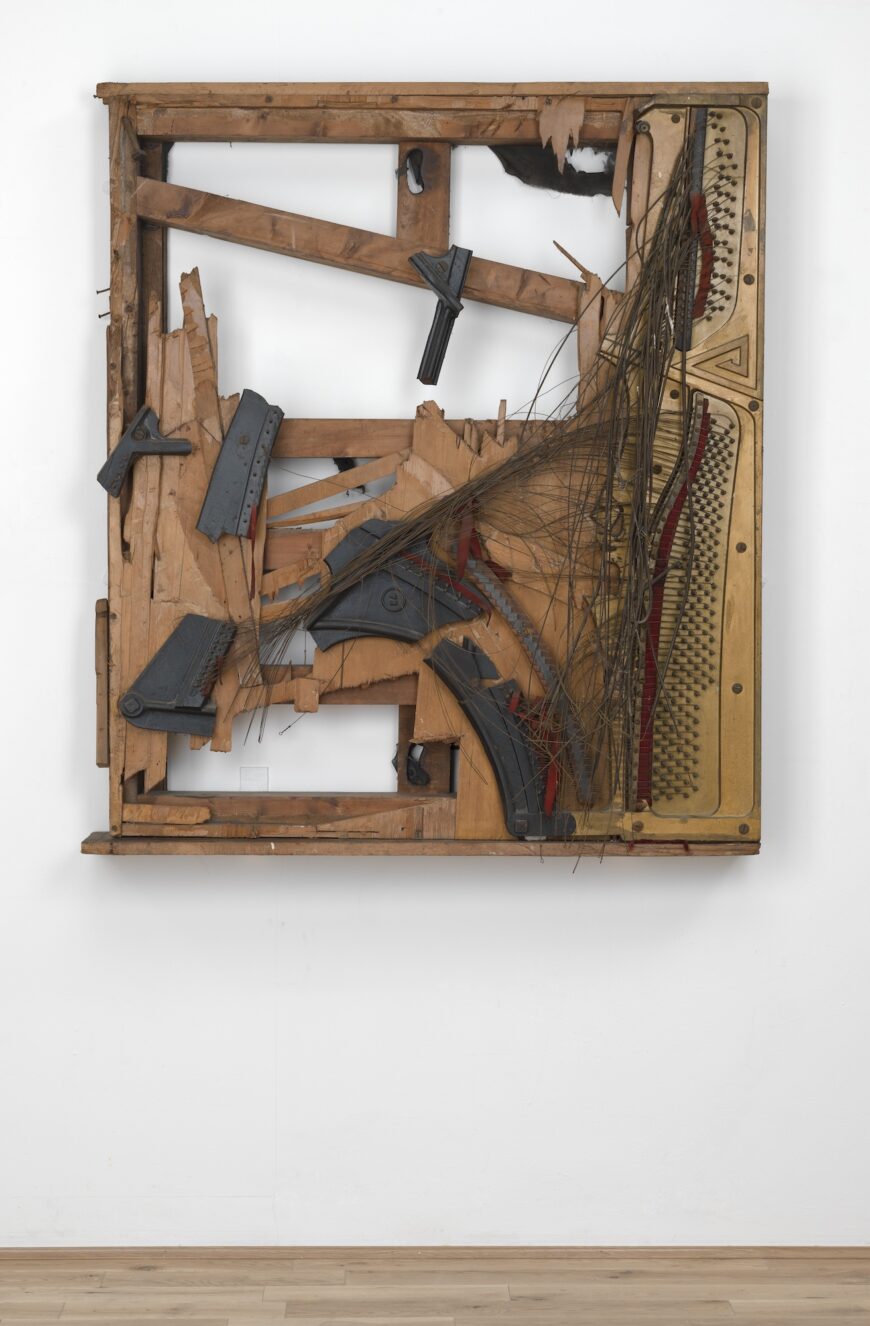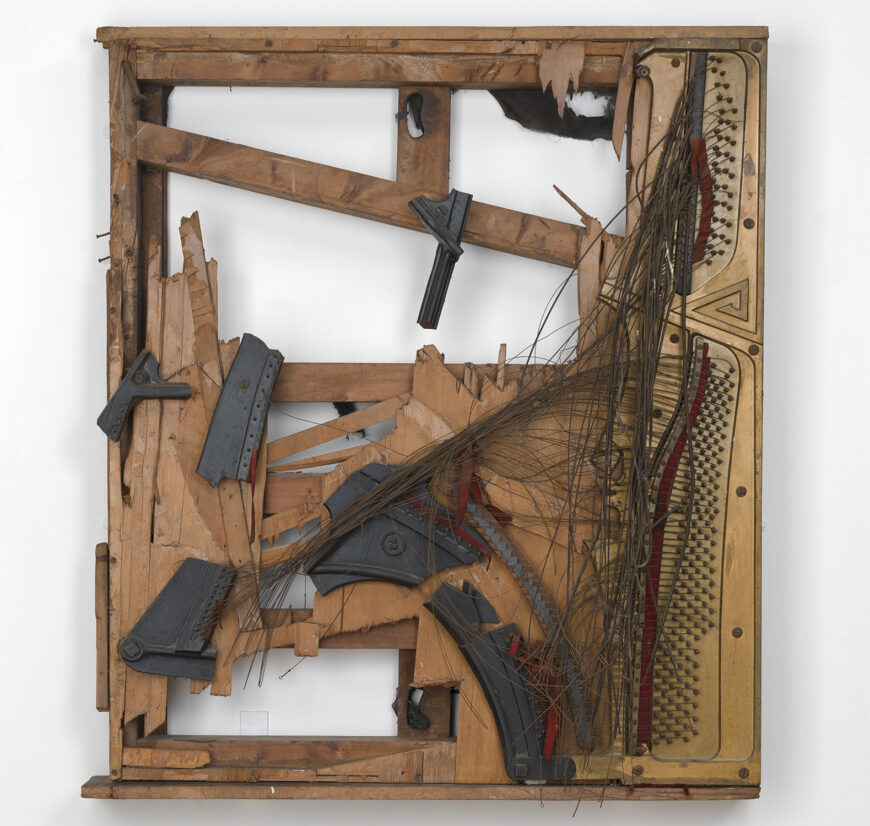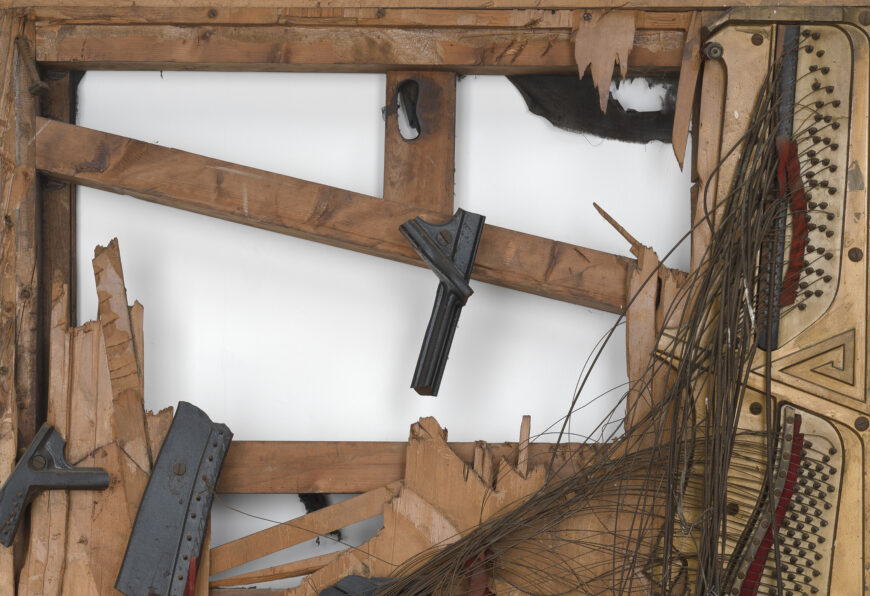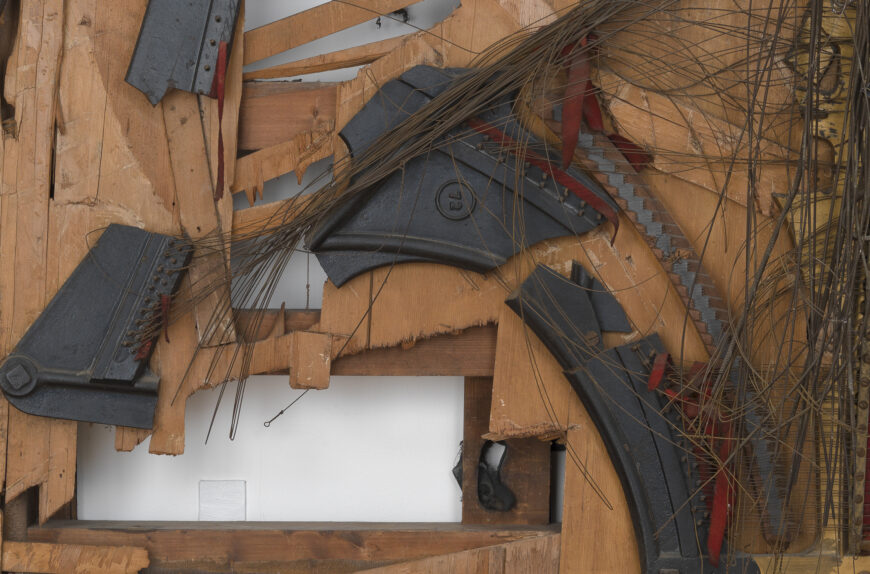
Raphael Montañez Ortiz, Duncan Terrace Piano Destruction Concert: The Landesmans’ Homage to “Spring can really hang you up the most,” 1966, wood, metal, paint, felt, textile, and nails, 142 x 124.5 x 28 cm (Tate Britain, London; photo © Tate) © Raphael Montañez Ortiz
The broken wooden frame of a destroyed upright piano hangs turned 90 degrees on the wall. The interior makeup of the instrument now lays exposed, with the various wooden boards of the back snapped in jagged pieces, strings cascading down and over, forming a tangled mess. The ornate metal plate of the harp makes a straight vertical line along the right side, a prominent triangular spiral from the original manufacturing creates an aesthetic contrast with the ruins of wood and metal. In its destruction, the forms and textures of the materials that make up the piano are now visible. It is no longer a functioning piano, but a new work of art that only hints at the movements and sounds of its final performance.
Rather than a complete finished sculpture, Duncan Terrace Piano Destruction Concert: The Landesmans’ Homage to “Spring can really hang you up the most” is the remains of a Piano Destruction Concert realized by Brooklyn-born Puerto Rican artist Raphael Montañez Ortiz in September 1966 for the Destruction in Art Symposium in London (DIAS). Throughout the month, Ortiz created a series of destruction realizations, his term for the live destruction performances. Duncan Terrace Piano Destruction Concert is one of the earliest remnants of Ortiz’s Piano Destruction Concerts, a destruction realization he repeated in some form for over fifty years with its remnants in museum collections around the world. Yet what makes a destroyed piano a work of art?
Destruction as art
Ortiz began destroying furniture in the early 1960s in a series titled Archaeological Finds. For the series, Ortiz gathered domestic objects from his home and studio, specifically chairs, couches, and mattresses. He then manually broke apart each object, using his hands and legs to tear at the wood, cotton, wire, and string. Ortiz linked the process of making Archaeological Finds to both an archaeological excavation and a ritual to unearth the materials of industrially produced objects like furniture. Such a process enacted a form of “deliberate encounters,” that enabled Ortiz to probe at the transformations that occur when two forces come together. [1] Ortiz references ritual as part of his own personal research into his family’s Indigenous ancestry (specifically Yaqui ancestry on his mother’s side) as well as more broadly to work through the effects of Western colonization of the Americas. In 1962, he wrote in his “Destructivism: A Manifesto,” that “as a mattress or other man-made object is released from and transcends its logically determined form through destruction, an artist….is also released from and transcends his logical self.” [2] Through destruction, Ortiz hoped to liberate himself and the object from Western conventions. Ortiz’s encounters with domestic objects were a way to destabilize how contemporary Western capitalist culture encouraged productivity for both objects and people.
Ortiz finished an Archaeological Find by fixing the destroyed objects to a plywood base and encasing the object in resin so they could be mounted on walls as works of art like the Duncan Terrace Piano Destruction Concert. However, Ortiz often worked on the Archaeological Finds in his studio for days and weeks. In contrast, the Piano Destruction Concerts are within the field of performance art: they invite viewers to experience destruction in person in real time as a work of art.

Raphael Montañez Ortiz, Duncan Terrace Piano Destruction Concert: The Landesmans’ Homage to “Spring can really hang you up the most,” 1966, wood, metal, paint, felt, textile, and nails, 142 x 124.5 x 28 cm (Tate Britain, London; photo © Tate) © Raphael Montañez Ortiz
The 1966 Destruction in Art Symposium
DIAS was a series of events organized by German-born Jewish artist Gustav Metzger and British poet John Sharkey that brought together artists, writers, sociologists, and psychologists from around the world to discuss the relationship between the uses of destruction in art. The press release announced: “The cataclysmic increase in world destructive potential since 1945 is inextricably linked with the most disturbing tendencies in modern art, and the proliferation of programmes of research into aggression and destruction in society.” [3] The symposium highlighted how artists creatively embraced destruction following WWII, specifically the Holocaust and the dropping of atomic bombs on Hiroshima and Nagasaki. Metzger himself was a refugee of the Holocaust whose family members were murdered by the Nazis.
While Metzger referenced the devastating effects of 1945, he and many other artists throughout the world were also contending with the Vietnam War, which was televised and reported on around the world. Beginning in 1965, the United States expanded its involvement in Vietnam, shifting from offering financial and military aid for France and South Vietnam to providing American ground troops and initiating immense bombing campaigns against North Vietnam. While many of the artists participating at DIAS, like Ortiz, had been working with destruction before the conflict’s escalation, their art took on greater moral implications as the spectacle of war filled televisions, magazines, and newspapers. Destruction in art gave artists opposed to the war an aesthetic outlet to confront its impacts on human life.

Destroyed piano (detail), Raphael Montañez Ortiz, Duncan Terrace Piano Destruction Concert: The Landesmans’ Homage to “Spring can really hang you up the most,” 1966, wood, metal, paint, felt, textile, and nails, 142 x 124.5 x 28 cm (Tate Britain, London; photo © Tate) © Raphael Montañez Ortiz
The sounds of destruction
How does one piece together an experience of a work realized over fifty years ago? In addition to the broken piano frame described above, Ortiz’s memories, photographs taken at the time and an audio recording help construct what this early Piano Destruction Concert looked and sounded like.
Ortiz realized this Piano Destruction Concert at the home of composer Fran Landesman and writer Jay Landesman. At their invitation, Ortiz destroyed the Landesmans’ own upright piano with an ax, a piano Fran often used to compose lyrics and songs, such as “Spring Can Really Hang You Up the Most,” as referenced in the work’s title. Before the performance, Ortiz had the piano properly tuned to be ready for a performance. Then, with the assistance of Jay and other attendees, Ortiz carefully began lowering the piano into the basement where the performance was to take place. However, a third of the way down the piano became stuck on its side, its feet facing Ortiz and the door. While it was not his intention to perform in the stairwell, Ortiz embraced how the stairwell helped amplify the sounds.
Listening to the audio recording, we can hear the rhythmic banging and knocking as Ortiz swings the ax into the wood, combined with the occasional low creak as the wood is separated and pulled. As the banging continues, it is interrupted by the reverberating sounds of the piano as the ax hits the strings, their deep notes echoing out behind the continued pounding. Ortiz alternates between the steady slam of the ax against the wood, the groaning creaks of the wood splitting, and the startling booms of the strings being struck.

Destroyed piano (detail), Raphael Montañez Ortiz, Duncan Terrace Piano Destruction Concert: The Landesmans’ Homage to “Spring can really hang you up the most,” 1966, wood, metal, paint, felt, textile, and nails, 142 x 124.5 x 28 cm (Tate Britain, London; photo © Tate) © Raphael Montañez Ortiz
The percussive sounds in Ortiz’s performance contrast starkly with the melodic sounds typically associated with pianos. Upright pianos, like the one owned by the Landesmans, were symbols of middle and upper-middle class status within Euro-American homes. Ortiz drew from non-European music and sound to distort the practice of the home recital, where guests gathered around the family piano for informal concerts. The Piano Destruction Concerts instead revealed an alternative visual and sonic life for the piano, and by extension, Ortiz hoped to reveal alternatives from Western culture for himself and those in attendance. He has noted that “sound is an important part of Indigenous ritual, and the drumming sounds of the pianos that resonates when I chopped them apart were an expansion of their voice…” [4] The Piano Destruction Concert brought attendees into the ritual performance so that they could hear the piano anew and witness the transformation of the object from an instrument of European gentility to an object with Indigenous possibilities.
At DIAS-London, Ortiz hoped that witnessing the object transformation in real time would reveal how destruction was neither inherently good nor bad, but instead a powerful part of existence that required the same level of investigation as creation. Ortiz’s destruction realizations joined those by Metzger and other participating artists such as Yoko Ono and Hermann Nitsch, who offered symposium attendees the opportunity to experience the social and spiritual dynamics of destruction, when it is liberatory and when it is catastrophic.
Since 1966, Ortiz has continued to perform Piano Destruction Concerts in museums, galleries, and even in the mountains of the Italian Alps. While the work gets repeated, Ortiz has also altered the performance, sometimes adding a sacred circle of offerings such as salt, chicken feathers, and eggs and inviting others to destroy with him. Such alterations reinforce that while the core destructive act remains the same, each Piano Destruction Concert is its own unique work adapting to the environment and moment in time when it was created, just as Ortiz did with Spring Will Really Hang You Up The Most in 1966.
This essay is part of Smarthistory’s Latinx Futures project and was made possible thanks to support from the Terra Foundation for American Art.





